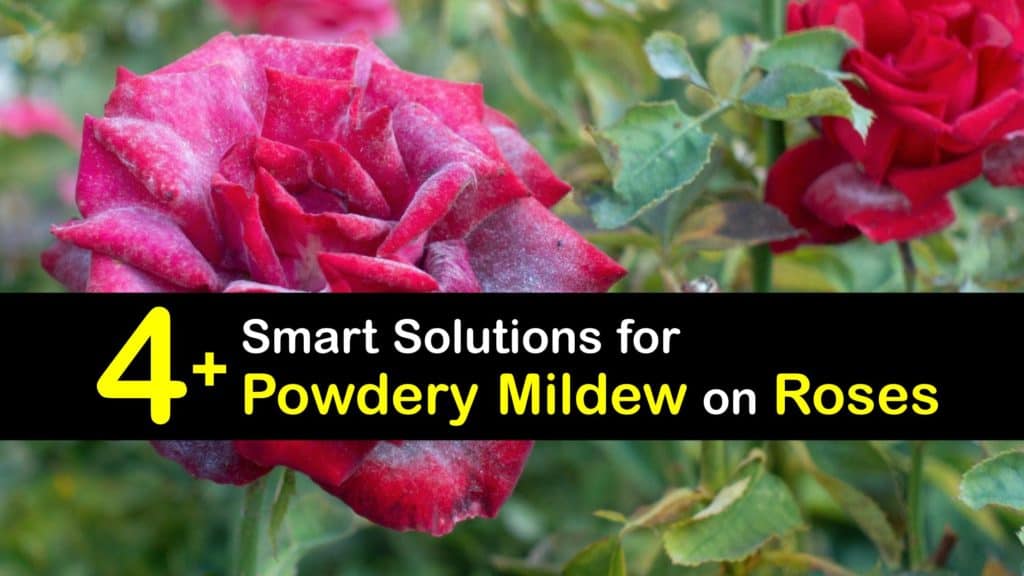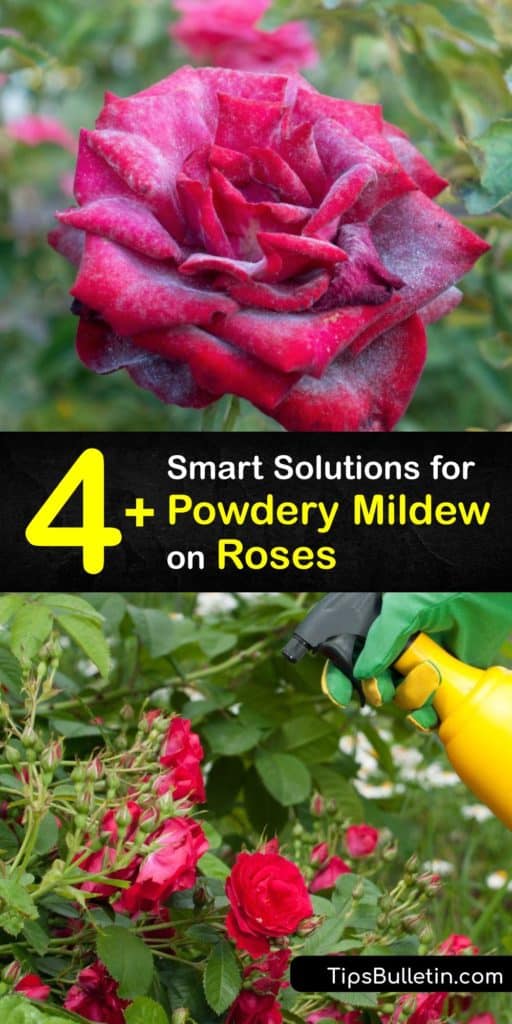We take great pride in our rose garden as rose-growers, tending to them daily while admiring their delicate yet strong beauty. And there is nothing more disheartening than finding infected buds and rose leaves covered with a fine layer of white powdery mildew growth. Therefore, we had to learn how to get rid of powdery mildew on roses to save our plants. Learn how to treat this fungal disease in your garden.
If you’re unsure whether your rose plants suffer from powdery mildew, the disease looks exactly like the name implies. It is a fine, white powder that grows on the dirt, stems, and leaf surface, and it affects a variety of different plants.
While discovering an infected plant in your flower garden seems like all of your plants are doomed, the powdery mildew infection is not as dire as it looks. This fungus shows up more than we’d like, especially in damp environments and areas with high humidity.

Eliminating and Preventing Rose Powdery Mildew
Learn what powdery mildew fungi are to help you know what to look for and understand the cause. Find out how to treat a powdery mildew infection on your roses and ways to prevent powdery mildew from returning in the future. These solutions work for heat tolerant roses and more delicate cultivars.
What Causes Powdery Mildew on Roses?
What exactly is that white dust on the foliage and soil of your rose plants? This white powder results from a common plant disease called white powdery mildew. Discover what it looks like and what causes the fungi to grow.
Powdery Mildew Disease
Powdery mildew (Golovinomyces orontii) is a fungal disease caused by various species of fungi, and many plants are susceptible to the disease, from crape myrtle to roses.
It appears as a light gray or white powder, and the fungal spores are attracted to damp areas. The white mold spreads quickly from the plant leaves to the stems and buds and even other plants if they are close enough.

Overwatering, poor air circulation, and accumulation of plant debris in the garden are common causes of this disease.
Treat Powdery Mildew on Roses with Fungicides
There are many fungicides on the market, and it’s confusing knowing which ones treat powdery mildew on roses. Here are some of the more popular methods to get rid of white fungus in soil and remove powdery mildew disease on flowers.
The first step in powdery mildew treatment is to remove the diseased parts of the plant. Prune away the infected leaf and stem and discard it away from the garden.
Treat the rose shrub by spraying the affected leaves liberally with your fungicide of choice.
The best fungicide for powdery mildew on roses is an application of potassium bicarbonate since it kills spores quickly and is approved for organic growing.
However, there are many other treatments on the market, including Neem oil, lime sulfur, and horticultural oil spray.
Home Remedy for Powdery Mildew on Roses
If you’d rather not use a store-bought plant fungi treatment, this home remedy for powdery mildew on roses, as a way to get rid of powdery mildew on tomatoes, or to take care of white mildew on grass, is easy to prepare and all you need is some baking soda and water.
Pour the water into a bottle and add the baking soda. Shake the container well to dissolve the powder and spray it over your entire rose plant.
If you have a large rose garden, make a gallon mix by combining four parts water with four teaspoons baking soda.
Use this mixture to treat powdery mildew on houseplants or to get rid of mold on houseplant soil, too. Keep a bottle on hand for quick application.
Here is How to Get Rid of Powdery Mildew on Roses with Vinegar
While using vinegar is one of the more aggressive ways to eliminate plant fungi, it’s effective if you have a severe case of mildew. Here is how to use apple cider vinegar to treat powdery mildew on roses.
Fill a garden sprayer with a quart of water and add two teaspoons of apple cider vinegar.
Avoid using white vinegar, which is more acidic than cider and may damage your plants. Spray the cider vinegar solution over the affected parts of your plants to treat powdery mildew. Use it for white tree fungus, as well.
If aphids are a problem, vinegar and water can be used as a home treatment for aphids on roses. If there are not too many, spraying them with the water hose is usually sufficient.
Preventing Powdery Mildew on Roses
While using a home remedy for powdery mildew on roses is simple, it’s even better if you eliminate the problem before it happens. Explore these tips for preventing powdery mildew spores from affecting susceptible plants.
Keep your rose bushes well-pruned to allow good air circulation. Clean the garden regularly to remove dead or damaged stems and plant debris that harbor mold spores.
Always water your plants at ground level since water droplets sitting on stems and leaves encourage powdery mildew.
It’s crucial to remove the infected leaf or stem by pruning as soon as you discover white powder on the leaves of your roses to stop the mildew from taking over your plant and spreading to other areas of your garden.
However, if you find a light case of mildew, spray it off the plant with water on a warm and dry day.
Consider planting disease resistant varieties to lessen the chance of dealing with powdery mildew in your garden.
Some good choices are the Iceberg rose, New Dawn rose, White Out rose, Ballerina rose, Love and Peace rose, and Tiffany rose.
These heirloom, hybrid, shrub, and climbing roses are hardy and less susceptible to powdery mildew and other common diseases.
Finding your beloved roses covered with downy mildew or powdery mildew is understandably shocking. However, the disease is simple to treat using simple solutions, and saving your plants is as easy as giving them a little extra TLC.

Now that you understand how to get rid of powdery mildew on roses and stop it from returning, why not share our rose powdery mildew treatment and prevention guide with the gardeners in your life on Pinterest and Facebook?